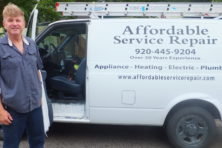Huge Repair, Building Costs Estimated for Gibraltar
- Share
- Tweet
- Pin
- Share

Gibraltar Area School Board members learned during a report on issues with the school buildings that costs for repairs could range from $21 million to $50 million.
Two construction-company officials this month noted that Gibraltar’s campus includes 10 building additions, and repairing and updating the oldest sections in the center of the school likely would cost more than demolishing them and building new.
The board planned to continue the process of informing the public about the building issues through public meetings. A joint meeting of the board’s Finance and Facilities Maintenance Committee is scheduled for Oct. 24, 4 pm, and the Door Community Auditorium Committee will meet at 5 pm that day. Both meetings are expected to include building discussions.
What’s Wrong with the Campus Buildings
The board initially asked for the assessment to determine the costs to replace old, inoperable windows; doors that didn’t seal out the elements; and other items needing repair.
Eric Schmidt, a senior vice president with CG Schmidt Construction of Milwaukee, said his crew members spent four days analyzing immediate repair and safety needs, mechanical equipment that’s reached its life expectancy, and eventual needs and upgrades that would bring the buildings, hallways, restrooms and learning spaces up to 21st-century expectations.
Schmidt and Brian Medina, a company vice president, provided a large menu of options for the board. A $21 million-plus project was the least expensive suggestion in their facilities-assessment report.
“That is just fixing things – not redesigning the space or making all the areas up to current codes,” Superintendent Brett Stousland said.
Another scenario that corrects everything that needs to be corrected or that could be updated in the oldest sections in all of the school buildings, creates classrooms with learning and collaboration spaces of the size most modern schools have, eliminates an unusually high number of ramps, makes all existing buildings compliant with current Americans with Disabilities Act standards, and builds a 25,000-square-foot addition to accommodate larger classrooms and wider hallway space would come in at more than $51 million, in the estimation of the CG Schmidt Construction executives.
Gibraltar School Board president Steve Seyfer said the board, district administration and employees, and community would need to prioritize projects over time.
“In the aggregate, we have a lot to consider,” Seyfer said.
Medina also presented an option of demolishing older sections of the school, rebuilding those spaces and correcting everything else in the school for about $37 million – approximately $14 million less than a “heavy renovation” schoolwide, including everything in the additions constructed between 1950 and 1980.
“This doesn’t mean there’s nothing right with your school,” Medina said. “It doesn’t stop you from doing day-to-day activities at the school.”
Many of the suggested repairs ranged from electrical outlets not matching modern codes, to tuckpointing and correcting cracks in the foundation. However, larger-ticket items were the replacement of roofs, doors and windows, and the boiler is at the end of its life expectancy.
Any major renovation would require asbestos abatement in portions of the school built in 1980 or earlier, and the 1954 and 1971 sections have galvanized piping “which will corrode and eventually leak,” Medina said.
Although the buildings are mostly accessible to people with disabilities, very little of the school would be in compliance with the Americans with Disabilities Act. Doors would need to be widened and restroom fixtures replaced, for example.
The most striking irregularity that Medina saw were the numerous ramps that connect buildings. Ten building additions were constructed atop various land elevations, and a series of ramps was used instead of digging into bedrock to keep the ground floors level with the additions. Although less expensive, the district now has some 30 wheelchair ramps that are narrower or nonconforming to ADA standards for slope, Medina said.
Other recommended improvements were more security cameras and better lighting for safety in many locations, as well as grounding and better air-conditioning and ventilation for the IT room. Only a fourth of the school buildings has LED lighting.
The consultants said their report was a “first-blush” estimation based on whatever they noticed, but that didn’t mean the school wasn’t habitable.
“We will follow a process of discussions to lead to a proposal in December, but there is no defined project or cost at this time,” Seyfer said.



